
Mahsa Dabagh, a biomedical engineer at UWM’s College of Engineering & Applied Science, specializes in computational modeling of how cells and organelles inside of cells sense and respond to changes in their surroundings. (UWM Photo/Troye Fox)
Cancerous tumors don’t happen in a vacuum. They develop in a cellular soup that can contribute to the disease’s progression.
Mahsa Dabagh, a biomedical engineer at UWM’s College of Engineering & Applied Science, knows this first-hand. Her specialty is computational modeling of how cells and organelles inside of cells sense and respond to changes in their surroundings.
Instead of relying on animal models to probe the micro-environment of cancer, Dabagh, an assistant professor, is building a virtual model of a human tumor, using data that characterizes the tissue on a molecular level. Tracking cellular changes of the tissue would provide the biomarkers that could reveal the stage of the cancer – or even predict if the tissue in question is likely to turn malignant or metastasize, she said.
The research is funded by a Faculty Early Career Development (CAREER) award just announced by the National Science Foundation. Dabagh will use the five-year $542,000 grant to construct the model and apply it to a prevalent type of pancreatic tumor, known as pancreatic ductal adenocarcinoma.
Patients with pancreatic cancer often don’t have physical symptoms, like pain, until the disease in its late stages or has spread to other places in the body.
“If we understand the cellular mechanisms of malignancy, and we track those, then we are in good place for prevention and treatment,” Dabagh said. “I believe this model will be very helpful in increasing earlier and more accurate cancer diagnoses.”
CAREER awards are the NSF’s most prestigious grants for early career researchers. They support the professional development of teacher-scholars who are most likely to become the academic leaders of this century.
For this project, she will take a comparative approach, modeling healthy tissue and diseased tissue to find the differences.
“Cancer cells move around to find the best place to grow,” Dabagh said. “Once we have a view of the changing composition, then we work backwards to find the biomarkers.”
Using atomic force microscopy to measure molecular forces in 3D, Dabagh and her lab members will determine biomechanical properties of different tissues and then feed that into the computational model. With cancer, for example, different levels of tissue stiffness signal malignancy or progressive malignancy, she said.
“We would also look for a vascular network starting to form around the tissue because blood vessels are needed for cancer to grow,” she said.
Another feature the team will track is the level of collagen fiber, a common fibrous protein in the body that provides structure to tissues. With pancreatic cancer, collagen fiber builds up, forming a thick layer of scar tissue around the tumor and blocking drugs from reaching the cancer cells.
A unique aspect of the model is that it can be personalized for individual patients by using their particular biological data.
Because the model will replicate the complexity and heterogeneity of a real human tumor, it could also be modified to use in revealing the progression of other diseases, such as atherosclerotic cardiovascular diseases, healing of chronic wounds and the spread of viruses. It also has promise as a platform to safely evaluate new drugs and treatments.
Written by Laura Otto
Link to original story: https://uwm.edu/news/uwm-scientist-lands-542000-nsf-award-for-modeling-virtual-tumor-tissues-2/
